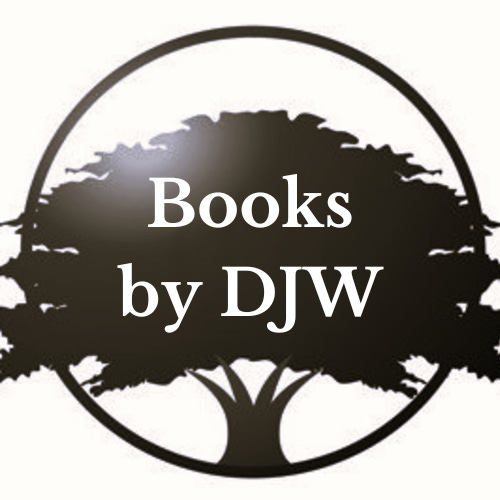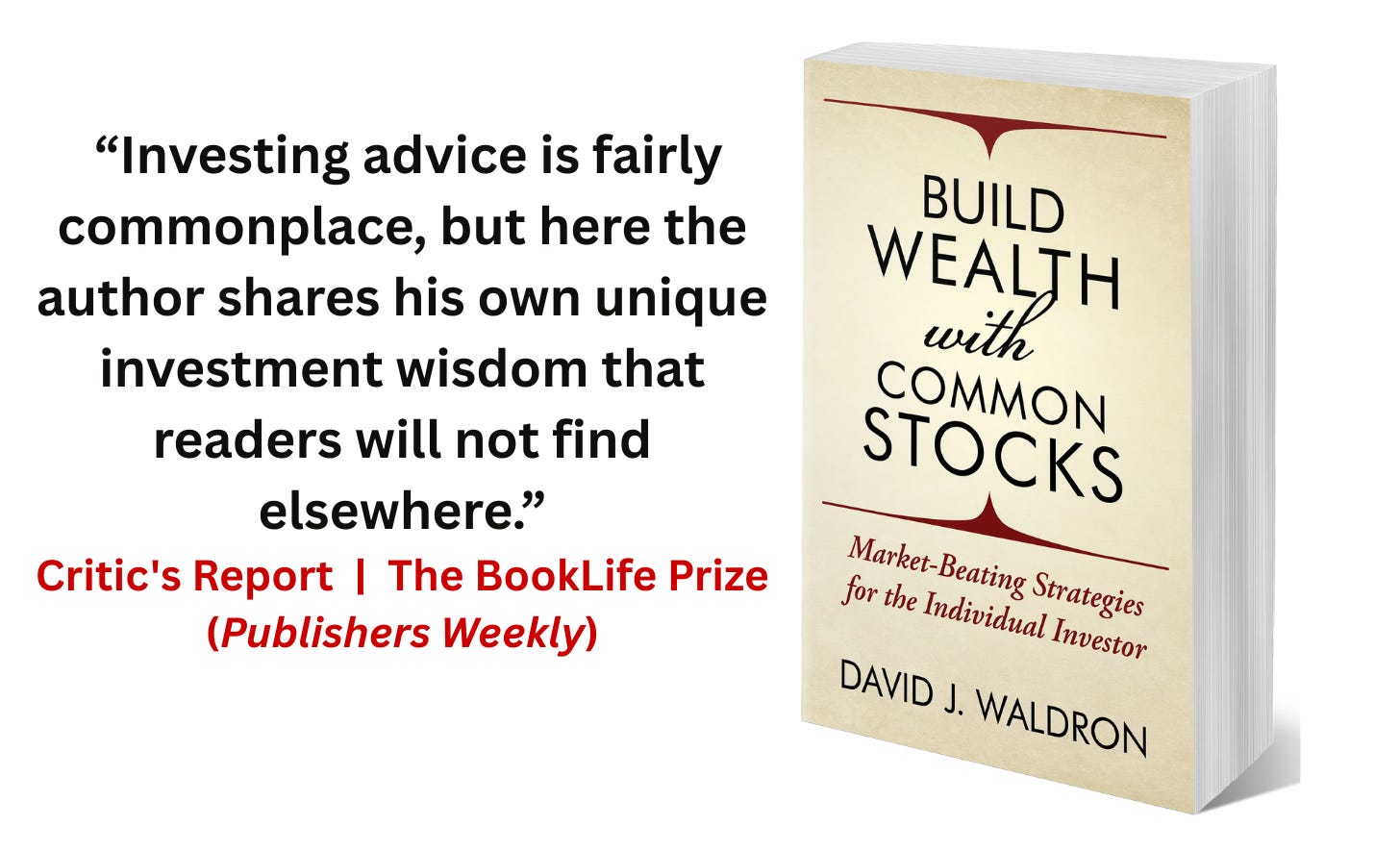Chapter Twelve: Quantify Shareholder Yields
Revised and updated | Build Wealth with Common Stocks: Market-Beating Strategies for the Individual Investor
Audio voiceover:
Substack’s AI-generated voiceover is available from “Books by David J. Waldron.” To access it, open the chapter in the Substack app. Feel free to share your thoughts in the comments or via direct message. I will use AI to clone my voice for the book’s official audiobook release.
Learn more about audio voiceovers:
https://davidjwaldronbooks.substack.com/p/audio
Haven’t read the previous chapters? Find them here on the book’s webpages:
Books by DJW Author Website
https://davidjwaldronbooks.substack.com/p/build-wealth-with-common-stocks
Quality Value Investing Newsletter
https://davidjwaldron.substack.com/p/build-wealth-with-common-socks
Part II: Strategies
Chapter Twelve
Quantify Shareholder Yields
When researching a stock for inclusion in The Model Portfolio, I consider the returns to shareholders a key indicator of whether the business is worth owning.
The thoughtful retail-level investor considers shareholder yields beyond just dividends. Like Warren Buffett, I view a stock's shareholder yield as similar to its equity bond rate.
A simple way to define the equity bond rate is to compare a company's returns and its underlying stock's returns with those of government bonds. While dividend yields are a standard comparison, consider two other metrics to measure the actual return to shareholders. These include averaging yields per share based on trailing earnings, free cash flow, and dividends.
Next, compare the total with the current Ten-Year Treasury rate. This proprietary equity bond rate modeling helps you determine whether a stock justifies the assumed higher risk compared to the perceived safer intermediate-term government issue.
Use this method to verify that the shareholder yield of your target stock is higher than the 10-Year Treasury rate. Even though these stocks may be out of favor on Wall Street, look for publicly traded companies that generate multiple, Treasury-beating shareholder yields.
This chapter presents an alternative yield approach to outperform Treasury rates without the restrictions of the dividend growth strategy—such as reliance on dividend history—or the risks associated with high-yield dividend investing.
Earnings Yield
The earnings yield (EY) is the annualized trailing earnings per share (EPS) divided by the stock’s closing price.
Earnings yield is the inverse of the price-to-earnings ratio (P/E). It is expressed as a percentage, making it easier to interpret than the P/E multiple, as it provides a comparable yield profile to bond rates. The EPS shows the portion of profits allocated to each outstanding share of common stock. Earnings yield indicates how the company’s earnings per common share compare to its stock price. A higher EY signifies stronger earnings per dollar invested.
When comparing stocks to prevailing bond rates, the earnings yield provides a more accurate measure than the dividend yield. Boards can raise or cut dividend payouts at will. Additionally, non-dividend-paying stocks also deliver earnings yields.
Look for stocks with earnings yields of at least 200 basis points—2 percentage points—above the Ten-Year Treasury yield. Targeting earnings yields above 6 percent equals price-to-earnings ratios below 17.
The higher the earnings yield and thus, the lower the P/E ratio, the more unfavorable the stock appears to the market. Nevertheless, as value investors, we focus on high earnings yields from quality enterprises for further research. The historic bull market that occurred during the writing of this book favored stocks over treasuries; however, the earnings yield remains a reliable barometer for deciding whether to favor common stocks over government bonds in any market cycle.
Earnings yield is a key margin-of-safety indicator for The Model Portfolio.
Free Cash Flow Yield
Free cash flow yield (FCFY) indicates how much a business generates in free cash flow per common share annually in relation to its stock price.
Therefore, the free cash flow yield is calculated by dividing the trailing free cash flow per share by the closing stock price. Free cash flow is defined as after-tax income minus preferred dividends, plus depreciation, depletion, and amortization expenses, net of capital expenditures. It provides a better indication of a company's bottom line than net profit.
Free cash flow enables senior management to increase shareholder value by investing in capital opportunities such as research and development, mergers and acquisitions, dividend payments, share buybacks, and debt reduction.
Some investors prefer free cash flow over earnings because of the GAAP/non-GAAP (generally accepted accounting principles) controversy surrounding earnings calculations. Analyzing both provides more information about a company, which benefits your understanding of the underlying stock. However, remember that free cash flow is a byproduct of earnings. The Model Portfolio stock screen in Part III, Chapter Sixteen, looks for a free cash flow yield above 7 percent, indicating a free cash flow multiple of fewer than fifteen times.
Earnings quality is also assessed by cash flow margin (CFM), which is operating cash flow divided by trailing sales. Operating cash flow is income after taxes minus preferred dividends and other distributions, plus depreciation, depletion, and amortization expenses. Favor cash flow margins above 10 percent. Think of CFM as a quick indicator of how senior executives manage cash flow from top to bottom.
Cash hoard per share — the total of cash on hand plus any short-term and liquid long-term investments on the balance sheet, divided by common shares outstanding — has gained attention in recent years. In simple terms, subtracting cash per share from the stock price gives an investor a clearer view of the enterprise’s intrinsic value, excluding cash and investments. Indeed, a small gap between the two prices presents an attractive investment opportunity. A cash hoard offers senior management buffers during economic downturns, interest-free financing for strategic acquisitions, and the ability to return capital to shareholders through stock buybacks or higher dividends.
Free cash flow yield is a key profitability metric for The Model Portfolio.
Dividend Yield
Target companies with a dividend yield or the annual dividend rate divided by the current stock price exceeding 2 percent but below 6 percent; however, buy the dividend-paying stock of a quality company trading at an attractive price, even if the historical yield is below 2 percent.
Trailing dividend yield shows how much a company paid in dividends over the past 12 months relative to its share price. The dividend rate is the total dollar amount of dividends paid during the previous fiscal year. Forward dividend yield represents the current twelve-month dividend rate divided by the stock price.
A value investor, unlike a dividend growth investor, looks for dividends to be paid in the short term while waiting for the investment thesis and capital appreciation to develop over time. Additionally, unlike the growth investor, a value investor places less emphasis on trailing and projected dividend payouts. As highlighted in Part I: Chapter Nine, avoid stocks with payout ratios or the percentage of net income allocated to dividends exceeding 60 percent.
Average the Sum of Total Yields
Now, compute the average of earnings, free cash flow, and dividend yields per share.
Calculating average yields based on trailing earnings, free cash flow, and dividends provides a snapshot of the stock's performance relative to the benchmark Treasury rate. The Ten-Year Treasury yield reflects the current published rate for the US Ten-Year Treasury note.
Shareholder Yields Rating
The shareholder yield rating is bullish if it is significantly above the Ten-Year Treasury rate, neutral if it approximates it, or bearish if it falls below it, based on the stock's average yield.
The Model Portfolio views a publicly traded stock's total shareholder yield as a primary indicator of the value of owning its shares.
Shareholder Yields Glossary
EPS Yield — earnings yield or twelve-month trailing GAAP earnings per share divided by the closing share price (CSP).
FCF Yield — the free cash flow yield, or the twelve-month trailing free cash flow per share divided by CSP.
Dividend Yield — trailing full-year dividend rate divided by CSP.
Average Yield — the overall average of earnings, free cash flow, and dividend yields.
Treasury Rate — the prevailing US Ten-Year Treasury yield or the equivalent government bond rate of another country.
I have found, through research and observation, that in the long run, the share prices of well-managed companies that outperform the Treasury benchmark are likely to outperform their peers in total return.
A Balanced Approach to Value Investing
Earnings per share are often debated due to creative financial engineering by company executives. Free cash flow, or the net cash remaining after capital expenditures and other asset costs, is a more accurate measure of the actual net earnings after income taxes and capital investments.
Nevertheless, earnings and cash flow yields are the primary valuation tools for assessing market sentiment toward a business, as they reflect the relationship between its bottom line and the stock price.
Most high-yield and some dividend growth investors prefer dividend yields well above the Ten-Year Treasury rate. Conversely, the disciplined investor remains cautious about dividends that can be affected by unpredictable stock price swings, unexpected rate cuts, or unsustainable payout ratios.
The dividend payout from an expensive stock is like purchasing or holding a dividend at a high cost. Value and price dominate every aspect of investing. Therefore, adopt a more balanced, value-based, buy-and-hold total-return approach.
Quantify Shareholder Returns Beyond Dividends
The thoughtful retail investor measures shareholder yields beyond the traditional dividend payout.
When investing in non-dividend-paying stocks, earnings and free cash flow yields serve as valuable valuation alternatives. However, as a shareholder, you deserve a compounding return or yield from each component of the earnings stream, including dividends.
If the shareholder yield underperforms the intermediate government bond benchmark, consider the company unworthy of an ownership stake due to its higher equity risk. The thoughtful investor views a stock as unattractive when its yield is lower than that of a Treasury bond or note backed by the US government's full faith and credit.
My proprietary method for measuring the equity bond rate is just one example. Also, consider what you are trying to discover as a do-it-yourself investor when building confidence that a targeted common stock could be more valuable than a traditional government bond over a long-term holding period.
In contrast to fixed-income investors, the disciplined stock investor avoids lending money to companies as a bondholder. Some gentlemen and gentlewomen prefer bonds, although the thoughtful investor favors the multiple shareholder yields of equities.
CHAPTER TWELVE SUMMARY
On Shareholder Returns
The returns to shareholders by a publicly traded company are a key indicator of the value of owning a piece of the business.
As a shareholder, you deserve a compounded return or yield from each leg of the earnings vertical.
Average the earnings, free cash flow, and dividend yields, and compare them to the Ten-Year Treasury rate to determine the equity bond rate of the individual stock.
Common shares that underperform the Ten-Year Treasury are no longer attractive options for the prudent buy-and-hold investor.
What other factors do you analyze to assess whether a targeted common stock could be more valuable than a typical government bond over a long-term holding period?
This updated chapter is copyrighted 2021 and 2025 by David J. Waldron. All rights are reserved worldwide.
Next in Build Wealth with Common Stocks | Part II Strategies | Chapter Thirteen: Measure the Return On Management
Universal links allow you to preview or purchase David’s published print or ebooks — each available globally at your preferred online bookstores — with one or two clicks, brought to you by our trusted partner, BookFunnel.
Share the “Books by David J. Waldron” author website with your network to earn credits for a premium subscription that provides full-text and audio access to all of David’s manuscripts and updated chapters of his published self-help books.







